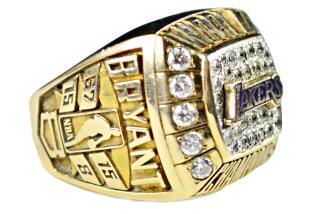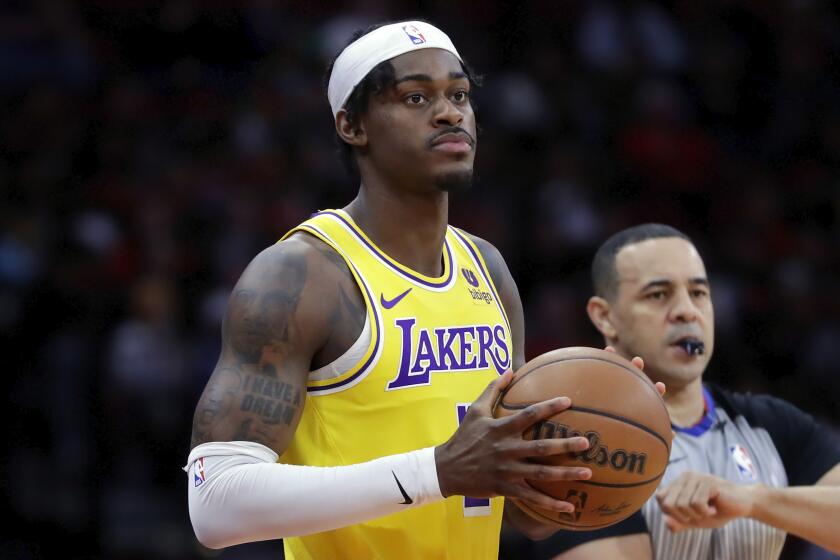Presumption of innocence sidelined
- Share via
If Scott Peterson is keeping score, he should award Kobe Bryant an assist.
The onetime Modesto fertilizer salesman accused of killing his wife and unborn child was set to become the plat du jour in this summer’s annual media feeding frenzy. Then, last week, a Colorado prosecutor charged the Laker star with sexually assaulting a 19-year-old woman employed at a resort hotel where he was staying before knee surgery.
The rest, to gloss the familiar phrase, is hysteria.
Pity the reportorial remnants still stuck in Stanislaus County -- if there are any -- because, at the end of the day, their only claim on their audience’s attention is a suburban murder with a little low-rent infidelity thrown in for titillation. Their Colorado colleagues, by contrast, are riding a real Rocky Mountain high -- that most intoxicating of journalistic phenomena, a crossover story.
Bryant’s case cuts in as many directions as a newspaper has sections: There’s the news coverage, of course, legal analysis and an endless supply of sports stories and columns. This time around, there are even stories for the financial pages, since Bryant reportedly makes as much as $13 million a year from endorsements and last month signed a four-year, $40-million deal to promote Nike shoes.
“Should Brands Bryant Endorses Keep Him On?” demanded a headline on the front page of Tuesday’s Wall Street Journal Marketplace section.
Then there are all the probing lifestyle features to be written about the scene of the alleged crime, Eagle County, Colo. Is it really an idyllic Alpine community of rough-hewn, plain-spoken cowboys and amiable, laid-back ski bums? Or is it a small town riven by petty jealousies, where bored teenagers are drawn to the high-octane drug-and-alcohol-fueled party scene at the tony resorts nearby? All this will be fodder for an unimaginable number of op-ed pieces and televised commentaries.
You, of course, may feel that you’ve heard it all before with other names and faces, but in the minds of assignment editors and producers, familiarity breeds content.
The top story in Tuesday’s New York Times sports section, for example, was a rhapsodic portrait of Mark D. Hurlbert, the 34-year-old district attorney who will prosecute Bryant. “Prosecutor Ready for Spotlight,” went the headline, “Undaunted by Attention and Moneyed Defense in Bryant Case.”
In “a two-hour interview at his office on Sunday,” Hurlbert said he “has heard all the daunting tales about small-town, cash-poor district attorney’s offices taking on legal dream teams” but takes solace from recent conversations with the Connecticut state’s attorney who successfully prosecuted Kennedy relative Michael C. Skakel. “That gives me hope,” Hurlbert said.
(Bryant happens to have hired two prominent Denver defense attorneys, hardly a dream team.)
Clearly the Colorado DA, who is “6 feet, 3 inches tall and sinewy,” did something for the two Times writers, who described him as having “those ice-blue eyes and sandy-blond hair belonging to a number of Colorado ski gods who seem to have been hatched from inside the same Alpine cave.”
Really?
The prosecutor’s hometown newspaper, the Vail Daily, was similarly concerned about the imbalance between Hurlbert’s finances and Bryant’s. In a front page story Tuesday, it reported that the prosecutor “is trying to determine how to best pit his relatively paltry $2-million budget against NBA basketball star Kobe Bryant’s $13-million annual salary.” The Daily went on to note that “Attorneys, sports experts and many others speculate [Bryant] will throw any amount of money he can toward the case to clear his name.”
How sinister.
There was a bromide widely circulated among commentators at the time of O.J. Simpson’s trial, that celebrities, particularly star athletes, are really the only people who actually enjoy the presumption of innocence to which all Americans accused of crimes are constitutionally entitled.
It was baloney then, and it’s baloney now. For most Americans -- and particularly for savvy, world-weary journalists -- the phrase “innocent until proven guilty” is simply rhetorical salve used to grease the rails that line the road to conviction.
In Bryant’s case, the pretrial abrasion of his presumed innocence has been magnified by two factors: One is his previously spotless record, which perversely has made him a greater object of attention than he otherwise would have been. Every aspect of this 24-year-old man’s heretofore unblemished record of precocious success is being subjected to a kind of revisionist consideration that more closely resembles vivisection than journalism.
His penchant for privacy, his intense self-discipline, his self-possession and measured distance from teammates and club executives suddenly have taken on a different cast. Maybe he isn’t a preternaturally gifted young man with an extraordinary sense of focus and self. Maybe he’s, well ... you know, weird.
Meanwhile, the cone of silence, which recently reformed criminal statutes and modern media custom reserved for women who lodge allegations of sexual assault, shields Bryant’s accuser from anything even remotely approaching the scrutiny to which his entire life now is being subjected. Mainstream media outlets, including The Times, for now have placed off-limits widely reported information that may shed light on the young woman’s personal situation and emotional state at the time she made her complaint.
To note this is not to argue that she should not be entitled to such privacy until a court deems the information relevant and admissible. But the question is, where is the similar deference to which Kobe Bryant is entitled?
After it hears all the evidence in his case, a Colorado jury may convict Bryant. Or, if its 12 men and women “cannot say they feel an abiding conviction of the truth of the charge” -- which is what the law defines as reasonable doubt -- they may find him not guilty.
But his fame and the presumption of innocence notwithstanding, Bryant and his lawyers are about to discover that by the time they get to trial, their first task will be to dig him out from under the rock pile of innuendo and suspicion created by all the rhetorical stones cast his way.
More to Read
Go beyond the scoreboard
Get the latest on L.A.'s teams in the daily Sports Report newsletter.
You may occasionally receive promotional content from the Los Angeles Times.










